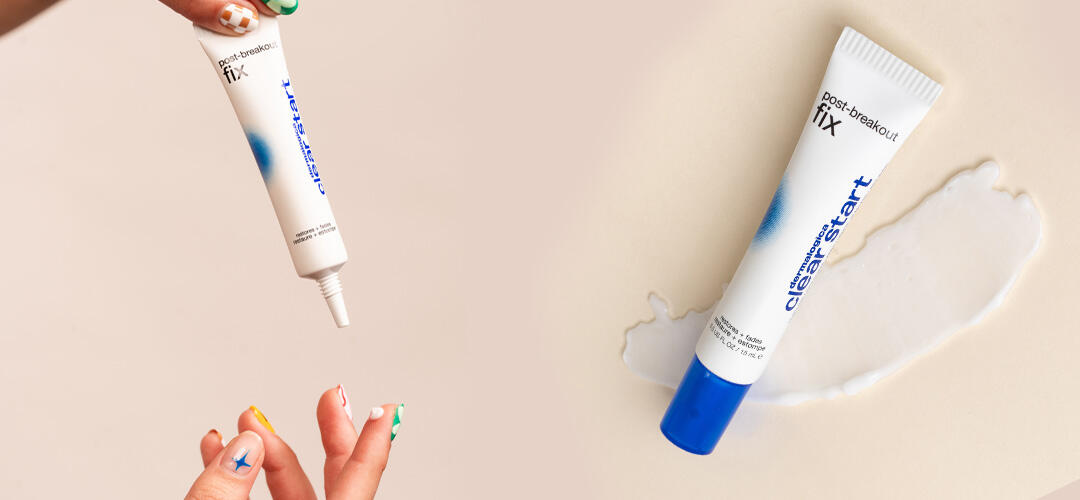
The breakout experts at Dermalogica Clear Start talk us through why young skins break out and what we can do to minimize spots and the pigmented marks they leave behind.
Why does younger skin tend to be oilier and breakout more?
One word, hormones! In our teens and early 20s elevated sex and growth hormones drive skin to produce more oil and skin cells leading to greasy skin and clogged pores. Skin easily becomes congested and without a consistent daily regimen, breakouts develop. We often find people with oily, breakout prone skin are exacerbating the problem by either not moisturising, over stripping the skin with astringent formulas, or not effectively cleansing the skin daily. It can be tricky to strike the balance between keeping skin clean and over striping the skin.
Is it true that oily skins or those with teen acne don’t need to moisturise?
Many people think that moisturiser will make them break out or just add unwanted grease and shine. However, it’s worth noting that without adequate moisture levels – that’s skin’s water content not oil content – skin produces more oil to compensate for the lack of moisture and we enter a viscous cycle. We notice dehydration on a lot of younger skins due to harsh, drying products that claim to bust breakouts but at the same time strip the skin of essential moisture. A hydrated skin functions much more effectively, in fact the natural shedding of dead skin can’t happen when skin is dehydrated. Holding onto dead skin is a key contributor to congestion and breakouts.

Talk us through how and why spots develop and why we get a dark mark afterwards..
Breakouts develop when a pore becomes congested. Dead skin cells and excess oil quickly form a plug in the pores cutting off the oxygen supply to the base of the pore. This is where spot causing bacteria start to thrive and grow in this anaerobic environment. As the pore becomes engorged with bacteria growth, the skins immunity kicks in to deal with the infection. This is where we see and feel the redness and swelling in a newly formed spot. As the infection is dealt with, we see puss at the head of the spot and if we can resist squeezing it, eventually the spot will recede and heal. Due to the inflammatory process during a breakout, skin pigment is produced leaving behind a mark. This is known as post-inflammatory hyperpigmentation or PIH.
Is it really not ok to squeeze your spots?
No, it’s not! Any professional skin therapist will tell you not to squeeze and for good reason. As we discussed with spot formation, there is infection and inflammation happening in the skin. When we come in with our fingers and pop the spot, we are causing more trauma and run the risk of spreading the infection. You may notice after squeezing a spot that another develops close by. You’re also extending the healing time as the skin now has to repair the damage to the pore from squeezing it. Constant picking and squeezing means a higher risk for scarring due to the damage caused and the likelihood is you’ll see more PIH which will take longer to fade. Rather use a breakout clearing formula for active breakouts that kills the spot causing bacteria and boosts healing. You can also get post-breakout formulas to fade the PIH marks.

What do you recommend including in a regimen to keep skin clear and healthy looking?
Dermalogica formulated Clear Start, designed especially for younger, breakout-prone skin. Clear Start combines potent, breakout-fighting ingredients with gentle, soothing botanicals to leave skin clear and comfortable – not inflamed or irritated. Here’s a simple 3 step regimen to help you clear breakouts and achieve a healthy-looking glow in record time.
Step 1 – CLEANSE
Wash your face twice a day with Breakout Clearing Foaming Wash to deep clean and purify the skin. This gentle wash with Salicylic Acid washes away dead skin cells, dirt and excess oils for fewer breakouts. It clears and soothes skin with botanicals and can be used all over face and body to treat and help prevent future breakouts.
Step 2 – TREAT
To target active, inflamed breakouts, apply Breakout Clearing Booster directly to breakouts AM and PM. This treatment product kills breakout causing bacteria in just 15 minutes! It stimulates natural exfoliation, helping to unclog pores and clear breakouts and unlike many drying spot treatments, soothes breakout-irritated skin.
To tackle post-breakout marks from healing spots, apply Post-Breakout Fix directly to post-breakout spots and repeat daily until marks fade. Actives including Hexylresorcinol and Salicylic Acid help fade the marks and improve skin tone.
Step 3 – MOISTURISE
To hydrate and refresh with none of the shine, apply Cooling Aqua Jelly daily. This skin refining, gel moisturiser helps reduce excess oil and refine skin texture, hydrates and cools skin for a refreshed feeling and calms and soothes while brightening the skin’s appearance.

Any further advise you can share?
If you’re struggling to bring your skin into balance, seek the advice of a professional skin therapist. Dermalogica therapists undergo extensive training making them experts in all things skin. They also offer PRO services such as the Clear Start Quick Extract Treatment that delivers clearer, calmer skin in just 20 minutes. Find your nearest therapist here.
clear start. clear conscience. clear skin. cleaner planet.
recycled plastic + forest-certified paper
In 2020, we began incorporating recycled plastic into our Clear Start packaging materials. All our cartons use Forest Stewardship Council (FSC) certified paper and several of our products are sold without cartons to reduce waste.
cruelty-free + certified vegan
We are recognized as cruelty free by PETA (People for the Ethical Treatment of Animals) and Leaping Bunny. Plus, all of the Clear Start products are certified as vegan.
no artificial colours or fragrances
Dermalogica has been clean since 1986. Our formulas are free of artificial colours and fragrances, mineral oil, lanolin, S.D. alcohol, parabens and microplastics.
